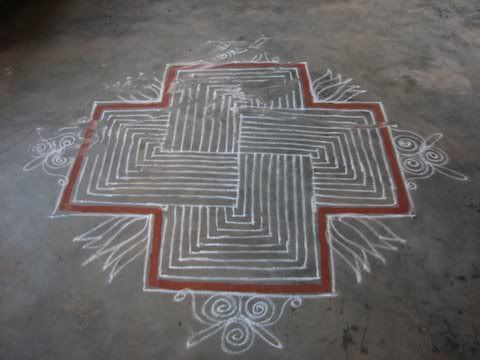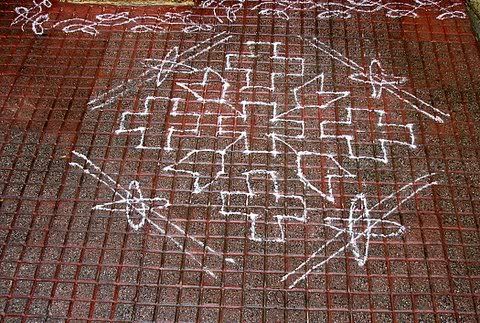kOlam
I do love the art of “kOlam”….it’s called “rangOli” in the north, but is executed very differently, and the designs are very different, too.
In south India, we have two ways of making kOlams; the wet (izhai kOlam) and dry (podi kOlam). I am reasonably good at both, but watched someone making the second type at a wedding, and thought I would document that.
Some kOlams are very simple, yet neat and geometrical; they speak of a few minutes devoted to the art as the housewife (or the maid!) has a lot of other work to attend to…
 Sometimes, red mud (chemmaNN) is also added as an outline for further beauty, and this is used during festivals and weddings. Here is another squarish "maNa kOlam" (which means Wedding kOlam)
Sometimes, red mud (chemmaNN) is also added as an outline for further beauty, and this is used during festivals and weddings. Here is another squarish "maNa kOlam" (which means Wedding kOlam)
 Many elements of Nature, such as snakes, birds, elephants, peacocks, and so on, are included in the kOLams. Some kOlams are purely mathematical; dots are put down in pre-designed patterns, and the kOlam is created around the grid.
Many elements of Nature, such as snakes, birds, elephants, peacocks, and so on, are included in the kOLams. Some kOlams are purely mathematical; dots are put down in pre-designed patterns, and the kOlam is created around the grid.
 That was what, in Tamizh, is called a "pAmbu" (snake) kOlam, because of the undulating lines.
The dots, and the way of connecting them, can be quite intricate. Here are two simpler ones, that I saw in front of my friends' home in Hyderabad:
That was what, in Tamizh, is called a "pAmbu" (snake) kOlam, because of the undulating lines.
The dots, and the way of connecting them, can be quite intricate. Here are two simpler ones, that I saw in front of my friends' home in Hyderabad:

 Here's one painted for longer durability:
Here's one painted for longer durability:
 I decided to take photographs, at a wedding I went to recently, of a lady making the kOlam.
Here she is, making a very basic "maNa kOlam"; it is usually a square with embellishments.
She has mastered the technique of putting down two parallel lines of kOlam together. and she is finishing, step by step, the curved embellishments over the square:
I decided to take photographs, at a wedding I went to recently, of a lady making the kOlam.
Here she is, making a very basic "maNa kOlam"; it is usually a square with embellishments.
She has mastered the technique of putting down two parallel lines of kOlam together. and she is finishing, step by step, the curved embellishments over the square:



 The other type of kOlam is the one done by dipping a small piece of cloth in rice paste, and then, with the help of two fingers, drawing the lines of the kOlam. This, of course, has hardly any margin for error! This kOlam works great on smooth dark floors, and here's an entry of mine from a Deepavali festival:
http://deponti.livejournal.com/142547.html
The other type of kOlam is the one done by dipping a small piece of cloth in rice paste, and then, with the help of two fingers, drawing the lines of the kOlam. This, of course, has hardly any margin for error! This kOlam works great on smooth dark floors, and here's an entry of mine from a Deepavali festival:
http://deponti.livejournal.com/142547.html
I do love decorating the front of my home to welcome visitors…there is also the superstition that the rice powder or paste will be eaten by small creatures such as ants and give them sustenance….
It’s still an art that’s vibrantly alive in our cities and villages! In the month of “mArgazhi” (mid Dec to mid Jan), women vie with one another to produce large, intricate kOlams, and competitions are held, too….

